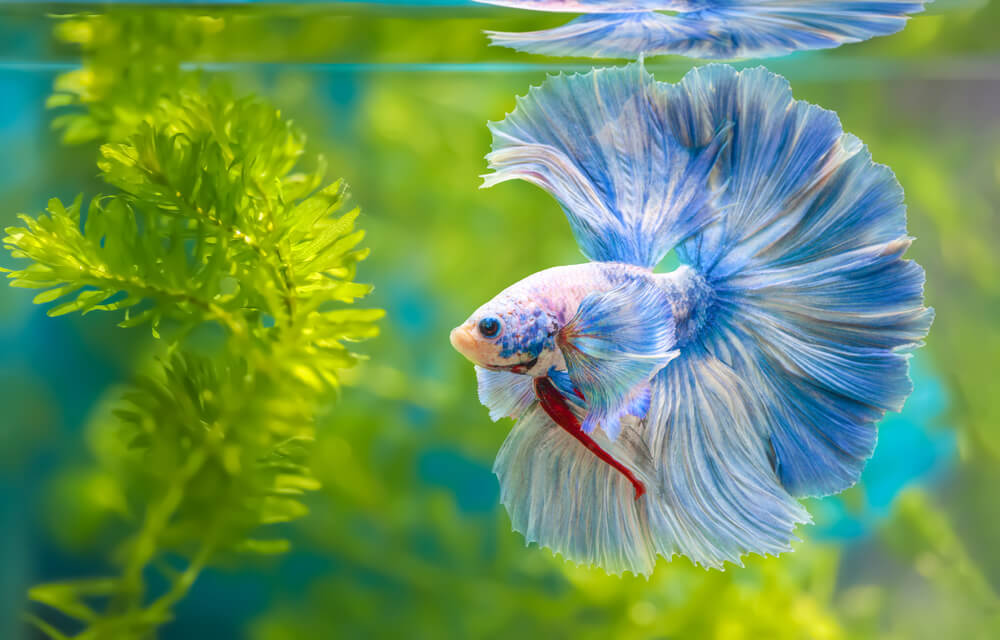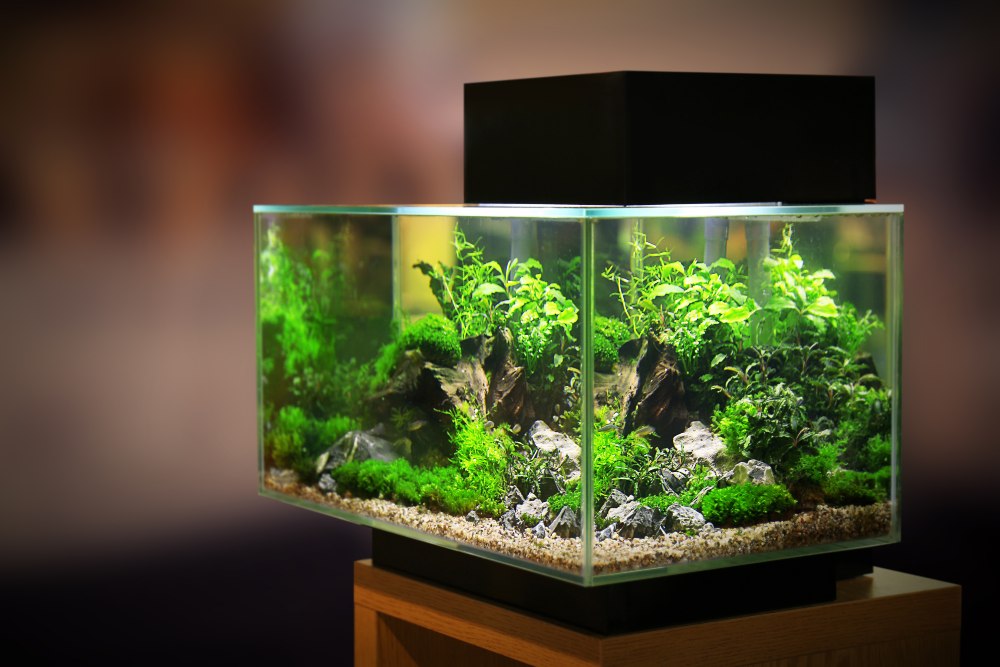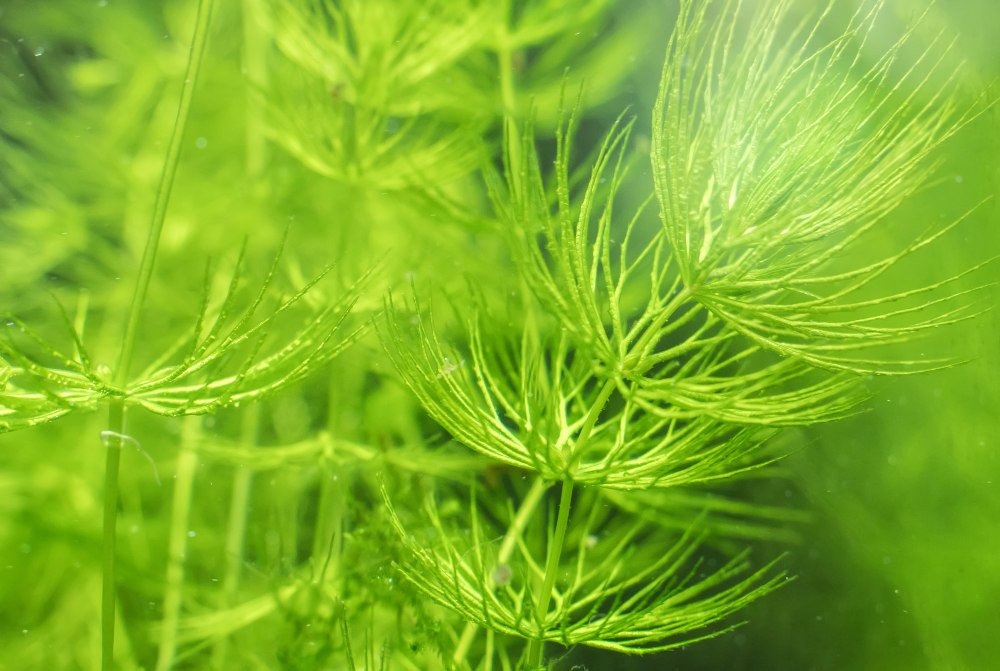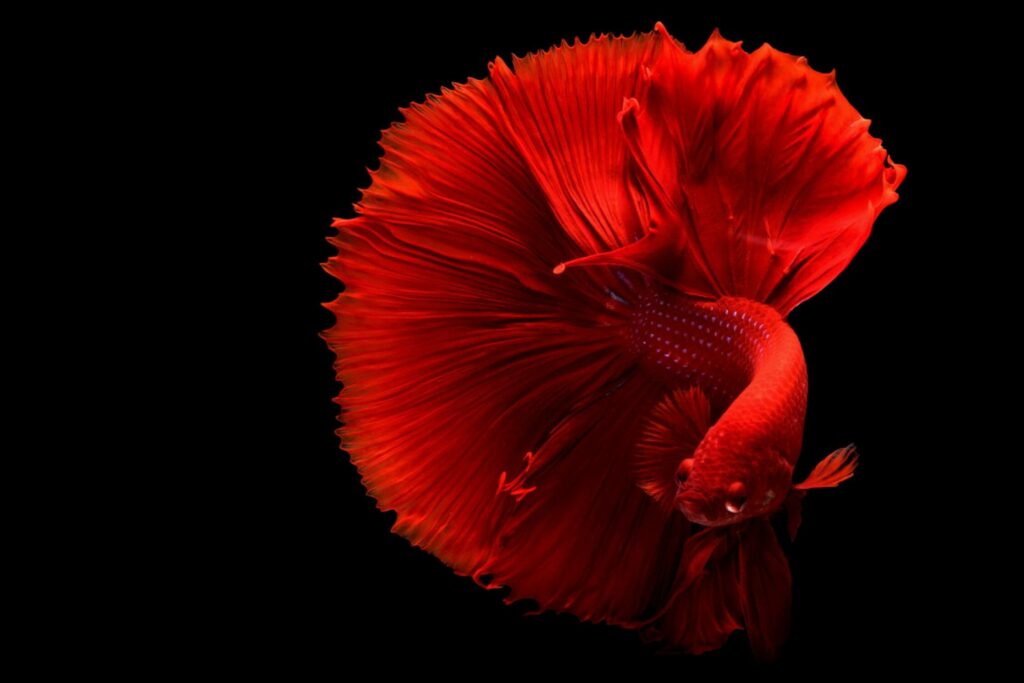Looking for a stunning fish to add to your aquarium? Look no further than the rosetail betta fish.
A rosetail betta—also known as a rose petal betta—is a fan favorite among fish enthusiasts, but they require more care and attention than other types of betta fish. However, don’t let that discourage you—with the right know-how, you can keep your rosetail betta happy, healthy, and thriving in your home aquarium.
Rosetail betta: an overview
| Rosetail betta overview | |
| Lifespan | 2-5 years |
| Length | 1.5 to 2 inches |
| Characteristics | Long, flowy tail that spans 180 degrees |
| Family | Betta splendens |

Rosetail bettas, a variant of the halfmoon betta, are freshwater fish known for their aggressive nature. Their long striking fins spread out at a full 180 degrees, resembling the petals of a rose, which earned them the name “rose petal betta.” Interstingly, their beautiful fins were actually the result of an accidental mutation.
Growing to about 1.5 to 2 inches in length and with an average lifespan of two to five years, Rosetail bettas are a unique and captivating addition to any aquarium.
Despite their beauty, many fish keepers opt to get a normal halfmoon betta over the rosetail variant. The delicate fins of the Rosetail betta are prone to frequent damage, with many betta keepers noting that their large fins can cause significant pain and difficulty swimming.
Additionally, the weight of their tail (in proportion to their body size) makes it challenging for them to swim when they are unwell.
Temperament
Although beautiful, rosetail bettas are just as aggressive as other types of betta fish. They are often referred to as Siamese fighting fish due to their territorial behavior. As with all betta fish, they have a natural territorial instinct and can become aggressive towards other fish or even their own reflection in a tank. However, their level of aggression varies on the individual fish and its environment. Proper care and a suitable tank setup can help to reduce aggressive behavior.
They are also known to be quite energetic and active, constantly swimming and exploring their surroundings.
Caring for a rosetail betta
This tropical fish needs special care. Here’s what you need to know to create the best environment for this aquarium fish.
Tank size

When it comes to providing proper care for your rosetail betta, the protection and maintenance of their beautiful, broad fins should be a top priority. You need a tank of at least five gallons for a single rosetail, and if you’re planning on housing other fish with your betta, a larger tank may be necessary.
Their delicate fins can easily become damaged when they come into contact with the walls of the tank or sharp tank decor (like plastic plants). To ensure your rosetail betta doesn’t damage their fins, give them a large enough tank with proper decorations.
Tank decorations

When designing your betta tank, try to replicate its natural home in the tropical waters of Southeast Asia. Make sure you have plenty of silk and live plants, so your betta fish has places to hide and explore. Consider adding in broad-leaved plants like Indian almond leaves, java fern, or Anubias.
Also include floating plants like dwarf water lettuce or water sprite. All these plants also serve as a source of natural shade, which these fish greatly appreciate.
When selecting a substrate–the material at the bottom of your tank–for your rosetail betta, steer clear of materials with sharp edges that can potentially harm their delicate fins. Instead, opt for options such as driftwood, small pebbles, or sand.
Additionally, you can add a “betta hammock” to the tank, which is a leafy-looking decoration that betta fish like to rest on.
pH and temperature
Halfmoon rosetail bettas thrive in warm water temperatures between 75 to 80 degrees. The water temperature should remain stable at all times.
Halfmoon rosetails prefer slightly acidic but mostly neutral waters. As such, the pH levels should be between 6.5 to 7.5. Fluctuation in water parameters (temperature and pH) can stress out the betta, leading to various illnesses like stress stripes. Therefore, try to keep the water parameter stable at all times by using tank heaters and checking the pH levels every two weeks.
Lighting
Keeping the right amount of lighting can be tricky with rosetail bettas. On the one hand, you need enough light for the plants in the tank to survive. On the other hand, rosetail bettas prefer shady and dimly-lit environments.
Keeping plenty of plants in the tank is the easiest solution, as your betta fish can retreat to shady areas and your plants can get the light they need. Your tank should also have a regular day and night cycle, recreating the original living environment of the rosetail betta fish.
Filtration
Rosetails need calm waters, and strong filters will stress your betta out and make it hard for them to swim. Strong filters can also damage the flowy fins of this beautiful fish.
Opt for a sponge filter or a filter with baffles, which will keep the tank clean and well-oxygenated at the same time, without creating a strong current within the tank.
Diet
Like all betta breeds, rosetail bettas are carnivorous. They require a high-protein diet filled with good quality fish pellets, live foods like brine shrimp, bloodworms, red wigglers, mosquito larvae, and floating pellets. Avoid plant-based food as it doesn’t contain enough protein to keep your betta fish healthy.
Be careful not to overfeed the betta fish. A good rule of thumb is to feed your betta fish once or twice a day, with small amounts of food that can be consumed in under two minutes. Overfeeding can lead to health issues such as constipation, obesity, and poor water quality.
Tank mates

Due to their aggressive nature, rosetail bettas prefer being alone. They have a tendency to nip at the fins of other fish and can be quite dominant, making them incompatible with other aggressive fish. But there are exceptions.
If you want to keep your rosetail betta in a community tank, go for docile species and bottom dwellers. These types of species won’t invade your betta’s space and will keep your tank in harmony.
There are several great options when considering tank mates for your betta fish, including guppies, African dwarf frogs, and neon tetras. Bottom dwellers like Plecos can also make a good tank mate.
You should also never keep two male bettas in the same tank. Due to their territorial nature, both males can harm each other until one is severely hurt. You can keep female bettas in a sorority tank, but that involves a lot of risks as well.
For beginners, we recommend keeping your rosetail betta in its own tank. That way, you don’t need to worry about what your fish are up to when you’re not watching their tank.
4 common rosetail betta fish diseases
All betta fish are susceptible to specific diseases like ich and velvet, but halfmoon rosetail betta fish in particular, have three diseases you need to watch out for:
1. Infection
The flowy fins of rosetail bettas are more likely to get caught in aquarium objects compared to other types of betta fish. If their fins get caught, they’ll try to swim away. As they swim away, their fins can rip and tear, ultimately leading to bacterial or fungal infections, fin rot, or fin loss.
The infection can escalate if the infected fish is kept in dirty tank waters. Always keep the tank water clean to avoid infections if your rosetail betta happens to tear or rip their delicate fins.
2. Fatigue
Fatigue is another common disease in rosetail betta that many people don’t know about. You may often find your rosetail betta fish not moving or resting on the hammocks or at the tank bottom because the weight of their extreme fins makes it exhausting to swim around. Make sure to give your rosetail betta fish plenty of places to rest—like hammocks—so they can collect their energy when needed.
3. Eating difficulty
If the rosetail betta is unable to swim and spends most of its time resting, it will stop eating. Additionally, the uneaten food may gather at the tank bottom, spoiling the aquarium water. You can remove uneaten food through regular tank cleanings.
4. Breathing difficulty
Sometimes, rosetail betta get so tired they stop swimming to the top of the tank and stay near the bottom. Unfortunately, the lack of atmospheric air at the tank bottom can lead to suffocation.
Keep your tank well-oxygenated by using a good filter and doing regular water changes.
Where to buy a rosetail betta
Unfortunately, halfmoon rosetail bettas are difficult to find, but not impossible. Breeding rosetail bettas is quite difficult due to their very low spawning rate, which is why you likely won’t find them at a pet store. Here are the two places you’ll most likely find rosetail bettas.
Betta breeders
The best place to buy a rosetail betta is from experienced betta fish breeders. Breeders can give you information on the health history and genetics of the fish before making your purchase. You’ll also (likely) have a great choice in colors if you choose to buy from a betta fish breeder.
Betta fish rescues
If you can’t find a betta fish breeder in your area that sells rosetails, consider searching through various betta fish rescues. Rescue centers rehome betta fish and you can often find various varieties of bettas that need homes.
The controversy around rosetail betta fish
Not everyone is in favor of rosetail bettas. In fact, rosetail bettas have become increasingly controversial as more people learn about them.
One of the biggest arguments against rosetail bettas is that their large fins prevent them from swimming properly. And as mentioned in the previous section, they are prone to diseases and illnesses that result specifically from their heavy fins.
Many people avoid getting rosetail bettas because of these reasons.
Conclusion
The fascinating dorsal fin, tail type, and bright colors make rosetail betta unique from other betta fish with shorter tails. But their spectacular finnage also causes other issues and health problems. Some people may prefer owning regular betta fish over the rosetail simply because they’re easier to care for and don’t have difficulty swimming.
However, other aquarists enjoy the challenge of keeping rosetails in their tanks and find the effort is worth the reward.
Our recommendation? You should only go for a rosetail betta if you can invest enough time to care for this tropical fish.
